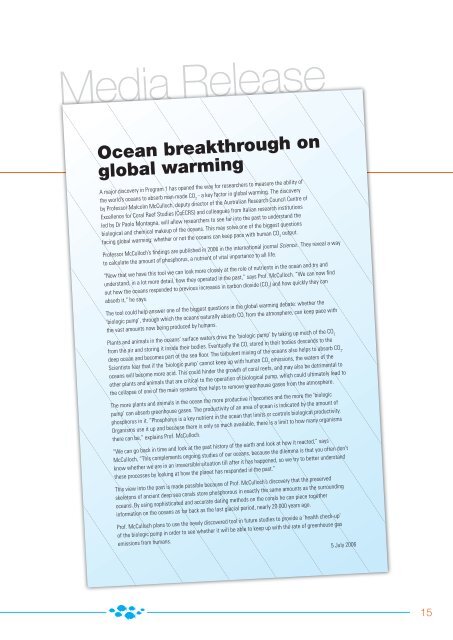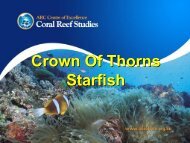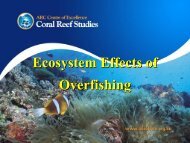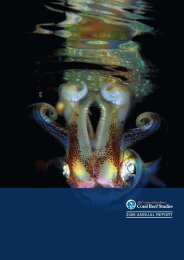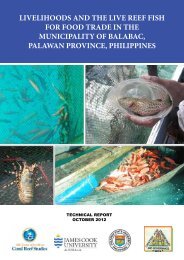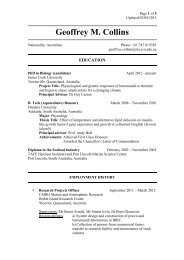Media ReleaseOcean breakthrough onglobal warmingA major discovery in Program 1 has opened the way <strong>for</strong> researchers to measure the ability <strong>of</strong>the world’s oceans to absorb man-made CO 2- a key factor in global warming. The discoveryby Pr<strong>of</strong>essor Malcolm McCulloch, deputy director <strong>of</strong> the Australian Research Council <strong>Centre</strong> <strong>of</strong><strong>Excellence</strong> <strong>for</strong> <strong>Coral</strong> <strong>Reef</strong> <strong>Studies</strong> (CoECRS) and colleagues from Italian research institutionsled by Dr Paolo Montagna, will allow researchers to see far into the past to understand thebiological and chemical makeup <strong>of</strong> the oceans. This may solve one <strong>of</strong> the biggest questionsfacing global warming: whether or not the oceans can keep pace with human CO 2output.Pr<strong>of</strong>essor McCulloch’s findings are published in 2006 in the international journal Science. They reveal a wayto calculate the amount <strong>of</strong> phosphorus, a nutrient <strong>of</strong> vital importance to all life.“Now that we have this tool we can look more closely at the role <strong>of</strong> nutrients in the ocean and try andunderstand, in a lot more detail, how they operated in the past,” says Pr<strong>of</strong>. McCulloch. “We can now fi ndout how the oceans responded to previous increases in carbon dioxide (CO 2) and how quickly they canabsorb it,” he says.The tool could help answer one <strong>of</strong> the biggest questions in the global warming debate: whether the‘biologic pump’, through which the oceans naturally absorb CO ²from the atmosphere, can keep pace withthe vast amounts now being produced by humans.Plants and animals in the oceans’ surface waters drive the ‘biologic pump’ by taking up much <strong>of</strong> the CO 2from the air and storing it inside their bodies. Eventually the CO ²stored in their bodies descends to thedeep ocean and becomes part <strong>of</strong> the sea fl oor. The turbulent mixing <strong>of</strong> the oceans also helps to absorb CO 2.Scientists fear that if the ‘biologic pump’ cannot keep up with human CO 2emissions, the waters <strong>of</strong> theoceans will become more acid. This could hinder the growth <strong>of</strong> coral reefs, and may also be detrimental toother plants and animals that are critical to the operation <strong>of</strong> biological pump, which could ultimately lead tothe collapse <strong>of</strong> one <strong>of</strong> the main systems that helps to remove greenhouse gases from the atmosphere.The more plants and animals in the ocean the more productive it becomes and the more the ‘biologicpump’ can absorb greenhouse gases. The productivity <strong>of</strong> an area <strong>of</strong> ocean is indicated by the amount <strong>of</strong>phosphorus in it. “Phosphorus is a key nutrient in the ocean that limits or controls biological productivity.Organisms use it up and because there is only so much available, there is a limit to how many organismsthere can be,” explains Pr<strong>of</strong>. McCulloch.“We can go back in time and look at the past history <strong>of</strong> the earth and look at how it reacted,” saysMcCulloch, “This complements ongoing studies <strong>of</strong> our oceans, because the dilemma is that you <strong>of</strong>ten don’tknow whether we are in an irreversible situation till after it has happened, so we try to better understandthese processes by looking at how the planet has responded in the past.”This view into the past is made possible because <strong>of</strong> Pr<strong>of</strong>. McCulloch’s discovery that the preservedskeletons <strong>of</strong> ancient deep sea corals store phosphorous in exactly the same amounts as the surroundingoceans. By using sophisticated and accurate dating methods on the corals he can piece togetherin<strong>for</strong>mation on the oceans as far back as the last glacial period, nearly 20 000 years ago.Pr<strong>of</strong>. McCulloch plans to use the newly discovered tool in future studies to provide a ‘health check-up’<strong>of</strong> the biologic pump in order to see whether it will be able to keep up with the rate <strong>of</strong> greenhouse gasemissions from humans.5 July 200615
Program 2:Understanding andManaging <strong>Coral</strong> <strong>Reef</strong>BiodiversityResearchersDavid Bellwood (Program Leader)Andrew Baird (Research Fellow)Sean ConnollyTerry Hughes (Research Fellow)Ge<strong>of</strong>frey JonesRonald KarlsonPippa Moore (Research Fellow)Philip Munday (Research Fellow)John PandolfiMorgan Pratchett (Research Fellow)Robert SteneckThough widely recognized as a criticalfactor <strong>for</strong> the maintenance <strong>of</strong> robustecosystems, biodiversity at local andglobal scales is poorly understood.Program 2 aims to understand themechanisms and processes that maintaincoral reef biodiversity, using a combination<strong>of</strong> mathematical modeling and fieldstudies. This multi-disciplinary approachin<strong>for</strong>ms knowledge-based management<strong>of</strong> biodiversity resulting in environmental,social and economic benefit to tropicalmaritime nations.Australian Research Fellow, PhilipMunday, in collaboration with colleaguesat the University <strong>of</strong> Cali<strong>for</strong>nia SantaBarbara, has identified the mechanismsunderlying the diverse sexual strategiesin sex-changing fishes. Munday’s 2006research, published in Proceedings <strong>of</strong> theRoyal Society, showed that the interplaybetween genes and the environment earlyin life plays a key role in which individualsbecome primary males or females. Thisresearch contributes to the increasingappreciation <strong>of</strong> the diversity and flexibility<strong>of</strong> sexual strategies in fishes.In a related study, Mark McCormick foundthat stressed fish have smaller <strong>of</strong>fspring,with lower chances <strong>of</strong> survival. Theability to cope with stress – and producelarge, healthy fry – determines whichfemales contribute to future generationsand influences the resilience <strong>of</strong> fishpopulations. Mark and Ge<strong>of</strong>f Jones havesecured a 3-year contract with the NatureConservancy to monitor coral reef health,biodiversity and fisheries resources in 4local marine reserves in Kimbe Bay, PapuaNew Guinea. The project will analyze theefficiency <strong>of</strong> current marine conservationef<strong>for</strong>ts and use this data to implementfuture marine conservation strategies inthe Bay.The increasing violence <strong>of</strong> storms underglobal climate change will have majoreffects on coral reefs – and has importantimplications <strong>for</strong> their future management.In a paper in Nature, JCU graduateJoshua Madin and Sean Connolly usemathematical models to calculate the<strong>for</strong>ces that coral is subjected to by wave,storm surge or tsunami, and the probability<strong>of</strong> the colonies being dislodged from thesea-bed. These new models provide anessential tool to predict how coral reefswill look under different future scenarios,and to plan accordingly.Understanding, predicting and managingthe potential impacts <strong>of</strong> climate changeon coral reef ecosystems is a major focus<strong>of</strong> many <strong>of</strong> the <strong>Centre</strong>’s projects. In 2006,Program 2 researchers examined theeffects <strong>of</strong> climate-induced coral depletionon coral reef fishes, in collaborationwith colleagues from the University <strong>of</strong>Newcastle-upon-Tyne and UC SantaBarbara. Work was conducted in Australia,Fiji, French Polynesia, PNG, and atseveral locations in the Indian Ocean,highlighting a new area <strong>of</strong> expertisewithin the <strong>ARC</strong> <strong>Centre</strong>. For example, ateam led by Australian Research FellowMorgan Pratchett documented significantpopulation declines and localizedextinctions <strong>of</strong> coral-feeding butterflyfisheson the Great Barrier <strong>Reef</strong>, following coralbleaching. Morgan and Andrew Bairdalso gave a series <strong>of</strong> briefings in 2006to the Western Australia oil and gasindustry, on a range <strong>of</strong> issues, includingthe use <strong>of</strong> coral spawning predictions<strong>for</strong> management, the scale <strong>of</strong> spatialstock-recruitment relationships, and theconsequences <strong>of</strong> recruitment failure <strong>of</strong>coral reef organisms.A series <strong>of</strong> high-pr<strong>of</strong>ile publications in2006 and 2007 demonstrate that fishwill play a vital role in the response <strong>of</strong>Australia’s Great Barrier <strong>Reef</strong> to climatechange. A team <strong>of</strong> 8 researchers fromProgram 2 and 5, led by <strong>Centre</strong> DirectorTerry Hughes, undertook a large-scalefish-exclusion experiment to explore therole <strong>of</strong> herbivorous fishes in bolstering theresilience <strong>of</strong> corals to global warming.The experiment tracked the recovery <strong>of</strong>corals following severe bleaching, in areas<strong>of</strong> reef where fish were experimentallyexcluded, and on adjacent areas withina no-fishing zone. In the absence <strong>of</strong> fish,the corals failed to recover, and instead aphase-shift occurred from dominance bycorals to a reef covered by dense stands<strong>of</strong> seaweed. Where fish were abundant,coral cover more than doubled, and noalgal bloom occurred. The team concludedthat maintaining intact fish populationswill be vital to successfully managing theresilience <strong>of</strong> tropical coral reefs from theimpacts <strong>of</strong> climate change and humanactivity. These results strongly supportmanagement strategies <strong>of</strong> the GreatBarrier <strong>Reef</strong> Marine Park Authority andother coral reef agencies worldwide. Theimportance <strong>of</strong> this project is accentuatedby the findings <strong>of</strong> the April 6 th 2007 report<strong>of</strong> the IPCC, which the <strong>ARC</strong> <strong>Centre</strong> <strong>of</strong><strong>Excellence</strong> contributed to.16


